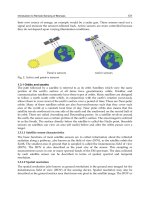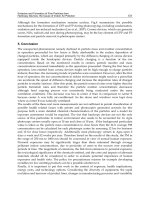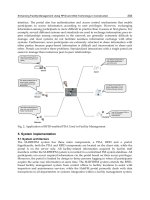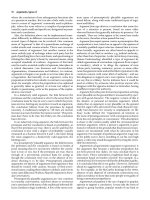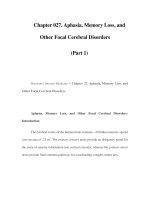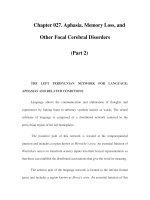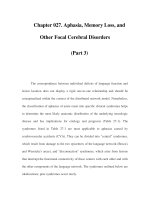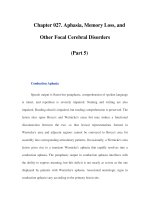Chapter 057. Photosensitivity and Other Reactions to Light (Part 8) pot
Bạn đang xem bản rút gọn của tài liệu. Xem và tải ngay bản đầy đủ của tài liệu tại đây (53.52 KB, 6 trang )
Chapter 057. Photosensitivity and
Other Reactions to Light
(Part 8)
Natural photoprotection is provided by structural proteins in the epidermis,
particularly keratins and melanin. The amount of melanin and its distribution in
cells is genetically regulated, and individuals of darker complexion (skin types
IV–VI) are at decreased risk for the development of acute sunburn and cutaneous
malignancy.
Other forms of photoprotection include clothing and sunscreens. Clothing
constructed of tightly woven sun-protective fabrics, irrespective of color, affords
substantial protection. Wide-brimmed hats, long sleeves, and trousers all reduce
direct exposure. Sunscreens are now considered to be over-the-counter drugs and
category I ingredients are recognized by the U.S. Food and Drug Administration
(FDA) as monographed and safe and effective. These are listed in Table 57-5.
Sunscreens are rated for their photoprotective effect by their SPF. The SPF is
simply a ratio of the time required to produce sunburn erythema with and without
sunscreen application. The monograph stipulates that sunscreens must be rated on
a scale ranging from minimal (SPF ≤2 and ≥12) to moderate (SPF ≤12 and ≥30) to
high (SPF ≥30, labeled as 30+). No SPF number >30 can be placed on the label.
Table 57-5 FDA Category 1 Monographed Sunscreen Ingredients
a
Ingredients Maximum Concentration, %
p-Aminobenzoic acid (PABA) 15
Avobenzone 3
Cinoxate 3
Dioxybenzone (benzophenone-8) 3
Ecamsule
b
15
Homosalate 15
Menthyl anthranilate 5
Octocrylene 10
Octyl methoxycinnamate 7.5
Octyl salicylate 5
Oxybenzone (benzophenone-3) 6
Padimate O (octyl dimethyl PABA)
8
Phenylbenzimidazole sulfonic acid
4
Sulisobenzone (benzophenone-4) 10
Titanium dioxide 25
Trolamine salicylate 12
Zinc oxide 25
a
FDA, U.S. Food and Drug Administration.
b
Recently approved by the FDA.
In addition to light absorption, a critical determinant of the sustained
photoprotective effect of sunscreens is their water-resistance. The FDA
monograph has also defined strict testing criteria for sunscreens making this claim.
Some degree of photoprotection can also be achieved by limiting the time
of exposure during the day. Since the majority of an individual's total lifetime sun
exposure may occur by the age of 18, it is important to educate parents and young
children about the hazards of sunlight. Simply eliminating exposure at midday will
substantially reduce lifetime UV-B exposure.
Phototherapy and Photochemotherapy
UV can also be used therapeutically. The administration of UV-B alone or
in combination with topically applied agents can induce remissions of psoriasis
and atopic dermatitis.
Photochemotherapy in which topically applied or systemically administered
psoralens are combined with UV-A (PUVA) is also effective in treating psoriasis
and in the early stages of cutaneous T cell lymphoma and vitiligo. Psoralens are
tricyclic furocoumarins that, when intercalated into DNA and exposed to UV-A,
form adducts with pyrimidine bases and eventually form DNA cross-links. These
structural changes are thought to decrease DNA synthesis and relate to the
improvement that occurs in psoriasis. The reason that PUVA photochemotherapy
is effective in cutaneous T cell lymphoma is not clear.
In addition to its effects on DNA, PUVA photochemotherapy also
stimulates epidermal thickening and melanin synthesis; the latter provides the
rationale for its use in the depigmenting disease vitiligo. Oral 8-methoxypsoralen
and UV-A appear to be most effective in this regard, but as many as 100
treatments extending over 12–18 months may be required to promote satisfactory
repigmentation.
Not surprisingly the major side effects of long-term UV-B phototherapy
and PUVA photochemotherapy mimic those seen in individuals with chronic sun
exposure and include skin dryness, actinic keratoses, and an increased risk of skin
cancer. Despite these risks, the therapeutic index of these modalities continues to
be excellent.
Further Readings
Lim HW et al: Sunlight, tanning booths, and vitamin D. J Am Acad
Dermatol 52:868, 2005 [PMID: 15858480]
Miller AJ, Mihm MC Jr: Melanoma. N Engl J Med 355:51, 2006 [PMID:
16822996]
Morison WL: Photosensitivity. N Engl J Med 350:111, 2004
Schade N et al: Ultraviolet B radiation–
induced immunosuppression:
Molecular mechanisms and cellular alterations. Photochem Photobiol Sci 3:699,
2005
Wong TH, Rees JL: The relation between melanocortin I receptor variation
and generation of phenotypic diversity
in the cutaneous response to ultraviolet
radiation. Peptides 26:1965, 2005 [PMID: 15963603]
